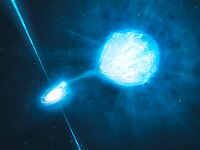
Photo from wikipedia
Considering the unexpected similarity between the thermodynamic features of charged AdS black holes and that of the van der Waals fluid system, we calculate the number densities of black hole… Click to show full abstract
Considering the unexpected similarity between the thermodynamic features of charged AdS black holes and that of the van der Waals fluid system, we calculate the number densities of black hole micromolecules and derive the thermodynamic scalar curvature for the small and large black holes on the coexistence curve based on the so-called Ruppeiner thermodynamic geometry. We reveal that the microscopic feature of the small black hole perfectly matches that of the ideal anyon gas and that the microscopic feature of the large black hole matches that of the ideal Bose gas. More importantly, we investigate the issue of molecular potential among micromolecules of charged AdS black holes and point out explicitly that the well-known experiential Lennard-Jones potential is a feasible candidate to describe interactions among black hole micromolecules completely from a thermodynamic point of view. The behavior of the interaction force induced by the Lennard-Jones potential coincides with that of the thermodynamic scalar curvature. Both the Lennard-Jones potential and the thermodynamic scalar curvature offer a clear and reliable picture of microscopic structures for the small and large black holes on the coexistence curve for charged AdS black holes.
Journal Title: Physical Review D
Year Published: 2017
Link to full text (if available)
Share on Social Media: Sign Up to like & get
recommendations!